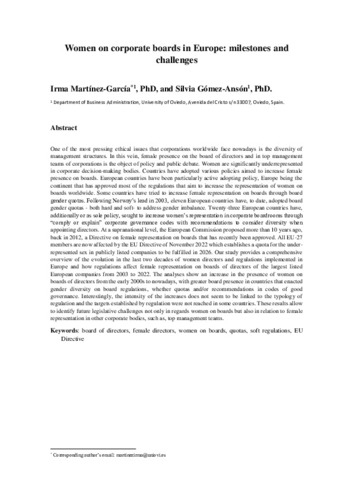Women on Corporate Boards in Europe: milestones and challenges
Autor(es) y otros:
Editor/Coord./Trad.:
Palabra(s) clave:
Board of directors
Female directors
Women on boards
Quotas
Soft regulation
EU Directive
Fecha de publicación:
Editorial:
Nova Science Publishers
Citación:
Descripción física:
Resumen:
One of the most pressing ethical issues that corporations worldwide face nowadays is the diversity of management structures. In this vein, female presence on the board of directors and in top management teams of corporations is the object of policy and public debate. Women are significantly underrepresented in corporate decision-making bodies. Countries have adopted various policies aimed to increase female presence on boards. European countries have been particularly active adopting policy, Europe being the continent that has approved most of the regulations that aim to increase the representation of women on boards worldwide. Some countries have tried to increase female representation on boards through board gender quotas. Following Norway’s lead in 2003, eleven European countries have, to date, adopted board gender quotas - both hard and soft- to address gender imbalance. Twenty-three European countries have, additionally or as sole policy, sought to increase women’s representation in corporate boardrooms through “comply or explain” corporate governance codes with recommendations to consider diversity when appointing directors. At a supranational level, the European Commission proposed more than 10 years ago, back in 2012, a Directive on female representation on boards that has recently been approved. All EU-27 members are now affected by the EU Directive of November 2022 which establishes a quota for the under-represented sex in publicly listed companies to be fulfilled in 2026. Our study provides a comprehensive overview of the evolution in the last two decades of women directors and regulations implemented in Europe and how regulations affect female representation on boards of directors of the largest listed European companies from 2003 to 2022. The analyses show an increase in the presence of women on boards of directors from the early 2000s to nowadays, with greater board presence in countries that enacted gender diversity on board regulations, whether quotas and/or recommendations in codes of good governance. Interestingly, the intensity of the increases does not seem to be linked to the typology of regulation and the targets established by regulation were not reached in some countries. These results allow to identify future legislative challenges not only in regards women on boards but also in relation to female representation in other corporate bodies, such as, top management teams.
One of the most pressing ethical issues that corporations worldwide face nowadays is the diversity of management structures. In this vein, female presence on the board of directors and in top management teams of corporations is the object of policy and public debate. Women are significantly underrepresented in corporate decision-making bodies. Countries have adopted various policies aimed to increase female presence on boards. European countries have been particularly active adopting policy, Europe being the continent that has approved most of the regulations that aim to increase the representation of women on boards worldwide. Some countries have tried to increase female representation on boards through board gender quotas. Following Norway’s lead in 2003, eleven European countries have, to date, adopted board gender quotas - both hard and soft- to address gender imbalance. Twenty-three European countries have, additionally or as sole policy, sought to increase women’s representation in corporate boardrooms through “comply or explain” corporate governance codes with recommendations to consider diversity when appointing directors. At a supranational level, the European Commission proposed more than 10 years ago, back in 2012, a Directive on female representation on boards that has recently been approved. All EU-27 members are now affected by the EU Directive of November 2022 which establishes a quota for the under-represented sex in publicly listed companies to be fulfilled in 2026. Our study provides a comprehensive overview of the evolution in the last two decades of women directors and regulations implemented in Europe and how regulations affect female representation on boards of directors of the largest listed European companies from 2003 to 2022. The analyses show an increase in the presence of women on boards of directors from the early 2000s to nowadays, with greater board presence in countries that enacted gender diversity on board regulations, whether quotas and/or recommendations in codes of good governance. Interestingly, the intensity of the increases does not seem to be linked to the typology of regulation and the targets established by regulation were not reached in some countries. These results allow to identify future legislative challenges not only in regards women on boards but also in relation to female representation in other corporate bodies, such as, top management teams.
ISBN:
Colecciones
- Administración de Empresas [514]
- Capítulos de libros [6525]
Ficheros en el ítem





